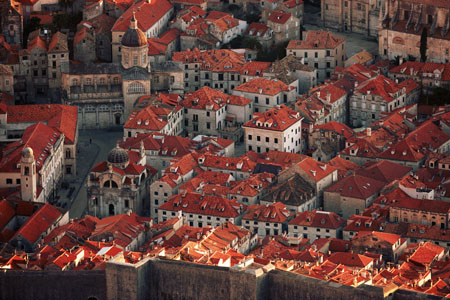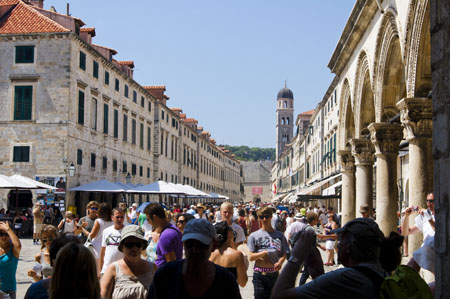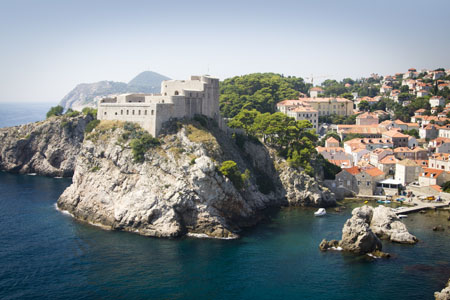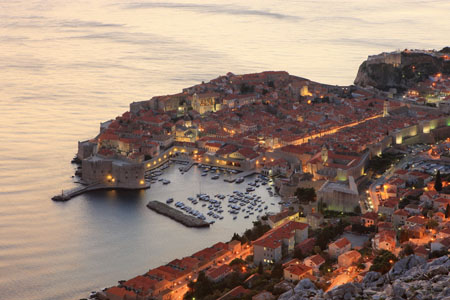We suggest the following TOP 10 sights…
1.City walls with forts The Dubrovnik city walls are the major attraction for visitors and one of the best preserved fortification complexes in Europe. The 1940-metre long walls encompass five forts and sixteen towers and bastions. The worlds second most attractive museum in the open air, the walls are open for visitors all the year round. The three entrances to the walls include those next to St Lukes Church in the east, next to St Saviours Church at the Pile entrance to the Old City and next to the Maritime Museum located at St Johns Fort. Taking a walk along the Dubrovnik city walls you will see some of the striking forts used for the defence of the Dubrovnik Republic. Of the five existing forts, Minčeta, Bokar and St John were built within the city walls complex, whereas the two freestanding ones include Lovrjenac in the west and Revelin in the east. Located at the highest point of the city Fort Minčeta protected Dubrovnik from the north. The fort is the symbol of Dubrovniks defence and the flag of our homeland waves on it all the time. In summer you can also see the Libertas flag flying on Fort Minčeta. In the southwest Fort Bokar, also called Zvjezdan, stands at the corner of the city walls facing Lovrjenac.
2. Lovrjenac Lovrjenac Fort is situated to the west of the Old City on a 37 metre-high rock. The symbol of Dubrovniks survival and freedom, the fort was used for the defence of the city and the western Pile gate. Above the entrance to the fort is the famed inscription: NON BENE PRO TOTO LIBERTAS VENDITUR AURO (Freedom is not sold for all gold in the world). The first official records mention the fort in 1301, although it is believed that its construction began earlier. Today Lovrjenac is well-known as one of the Dubrovnik Summer Festival open-air venues particularly suitable for works by William Shakespeare. Among the finest actors who appeared here in the role of the unfortunate prince of Denmark are Rade Šerbedžija, Daniel Day Lewis and Goran Višnjić.
3. Stradun The residents of old Dubrovnik entered the city through two main gates, the eastern gate at Ploče and the western one at Pile. The draw bridges were pulled up at night to prevent passage to uninvited visitors. Entering the Pile gate, where one can see costumed city guards in summer, you come to the principal street called Placa or Stradun. The main open-air public space of Dubrovnik, the favourite promenade and meeting place, the venue of all great festivities and processions, Stradun is the main shopping area and the widest and most beautiful street which divides the Old City into its northern and southern part. Its origins go back to the 11th century, when the people filled up the shallow sea channel which separated the one time Islet of Lave and a settlement on it from the land where another settlement existed. Placa acquired its proper function in the late 12th century when both settlements were joined into one urban unit by a city wall complex. The name Placa comes from the Latin term “platea communis”, denoting the venue of all major public events. The second name Stradun has a Venetian origin and means a large street. The Large Onofrio Fountain stands at the eastern end of Stradun. It was named after the constructor of the 11,7- kilometre long Dubrovnik water supply system from the 15th century, which supplied the stone city with water from the village of Šumet located in the Dubrovnik hinterland. The Orlando Column is the symbol of statehood. On its pole, where the flag of the Dubrovnik Republic once flew, the Croatian national flag now stands. During the Festival of St Blaise, the Dubrovnik patron saint, the column is bedecked with a flag with his image, and during the Dubrovnik Summer Festival with the Libertas flag.
4. Churches If you stay in Dubrovnik for several days, you might like to attend mass in one of the beautiful ancient atmospheric churches where you will surely find peace in the dim light and smell of flowers and frankincense… It will be in complete contrast with the glaring summer sun reflecting on the white Dubrovnik stone and the bright summer clothes of its numerous visitors. The cool interior of the churches will feel good after an exhausting walk in the hot streets. You might only light a candle made of genuine yellow wax and perhaps be lucky enough to enter St Blaises Church when somebody is playing the church organ, while the suns rays shine through the stained-glass windows illuminating the dark space of the church.
5. Squares A walk in the city streets and Stradun will certainly take you to some of the numerous Dubrovnik squares. Situated in front of the Cathedral, the Marin Držić Square leads to the city district of Karmen, to the city harbour and to the Aquarium. The people of Dubrovnik once called it “in front of Our Ladys Church”. The buildings in the square include the Dubrovnik Cathedral, the Sorkočevič Palace, the little Church of St Bartholomew, the Dulčić-Masle-Pulitika Gallery and the Memorial Room of the American Minister of Economics Ronald Brown who died on 3 April 1996 when his American plane crashed on St Johns Hill. The square was named after Marin Držić – Vidra (Dubrovnik 1508 – Venice 1567), the playwright, poet, conspirator and church organist. He studied in Dubrovnik and in Italy. In 1541 Držić was appointed Vice-Chancellor of Siena University. While staying in Florence in 1566 he asked the help of Cosimo Medici in overthrowing the Dubrovnik Republic regime and in introducing a system in which persons who were not of noble birth could also govern. In his works he wrote about the universal human themes: love, longing for youth and miserliness. Držićs plays vibrate with the vitality of life. His best-known works include Tirena, Grižula, Venus and Adonis, The Story of Stanac, The Miser, Hecuba and Uncle Maroje. In his comedy Uncle Maroje Držić conjured up a vision of a society of equals with no difference between good and bad people, portraying the main feature of his time – miserliness. A statue of the Dubrovnik poet Ivan Gundulić (Dubrovnik 1589 – 1638) stands in the Gundulić Square. Educated in his native city, Gundulić was appointed Rector of Konavle twice, a senator, Minor Council member and envoy to a Bosnian pasha. The major representative of the Baroque style in Dubrovnik, he wrote works which reveal the spirit of the Catholic reformation. His main motifs include realisations about the transitoriness of human life. Among Gundulićs best-known works are Tears of the Prodigal Son (Venice, 1622), Dubravka (performed in Dubrovnik in 1628) and Osman (printed as late as 1826). He was buried in the Franciscan Church, and the oldest copies of Osman from 1652 and a copy from 1826 printed in Dubrovnik are kept in the Franciscan Monastery library. Apart from the statue of Gundulić from the 19th century, a small Amerling Fountain – damaged during the aggression in 1991 – stands in the square of the same name, which was constructed after the disastrous earthquake in 1667.
6. Island of Lokrum The first records of the Island of Lokrum from 1023 mention it as the venue of the foundation of a Benedictine Abbey and Monastery. Legend has it that after a shipwreck on his way back from the Crusade in Palestine, Richard the Lionheart found shelter precisely on the Island of Lokrum in 1192. As a sign of gratitude should he be saved, he made a vow to build a church in the place where he would come ashore. However, he fulfilled his vow only in part. Upon the request of the people of Dubrovnik, Richard the Lionheart provided the money for the continuation of the building of the cathedral within the city. In 1839 Maximilian von Habsburg visited and bought the Island of Lokrum. He had his summer residence built on the ruins of the monastery with a magnificent garden, walking paths and promenades. The tradition of gardening and cultivation of exotic plants from the time of the Benedictines via Maximilian von Habsburg until today was continued in 1959, when the Botanical Garden was founded. The majority of plants were brought from Australia and South America, and the collection of eucalyptuses, cactuses and succulent plants is a special attraction. In 1963 the Island of Lokrum was declared a Natural Reserve and in 1976 a Special Forestry Reserve. A small lake on the island called Mrtvo More (Dead Sea), connected with the open sea, is suitable for children and non-swimmers. Located on an elevation, the star-shaped Fort Royal, built by the French in 1806, offers a magnificent view of Dubrovnik, Cavtat and the islands. In only ten minutes, a boat from the Old City Harbour will take you to the nearby Island of Lokrum, a favourite excursion place also known as the Island of Love.
7. Trsteno The name of this village situated some twenty kilometres west of Dubrovnik comes from the Croatian word trstika (cane), which grows in the area thanks to an abundance of water. Two giant Asian plane-trees (Platanus Orientalis), which are more than 400-year old, growing in a little square, are considered the biggest trees of their kind in Europe. The greatest attraction in the village is the magnificent Trsteno Arboretum, the only one on the Croatian Adriatic coast, which combines the rich cultural and natural heritage. The arboretum, renowned for its historic gardens and a collection of Mediterranean and exotic plants, was founded in 1948 in the area of the summer residence of the Dubrovnik Gučetić-Gozze aristocrat family. The entire arboretum is a protected monument of garden architecture. Spreading over 25 hectares, the Trsteno Arboretum comprises a number of different units: the historic Renaissance garden with the summer residence, the historic neo-romantic garden from the 19th/20th century, the historic olive grove and the natural vegetation of the woods of the Downy oak, Alpine pine tree and cypress, as well as the vegetation of macchia and coastal rocks. In 1494, at the time of the Renaissance, Ivan Marinov Gučetić-Gozze built a summer residence with a garden on his Trsteno estate, which soon became one of the humanistic cultural centres of Dubrovnik. In this Arcadian idyll, numerous Dubrovnik poets – including one of the most beautiful women of the Croatian renaissance, the Dubrovnik poetess Cvijeta Zuzorić – wrote their verses and had love affairs. One of the arboretum attractions – the garden fountain – was supplied with water by a 70-metre long aqueduct resting on fourteen arches. In 1736 the former Renaissance fountain was turned into a luxuriant Baroque nymphaeum with the god of the sea and waters Neptune as the central figure in a stone statue group.
8. Elafite Islands In the course of history the Elafite Islands relied on the city of Dubrovnik and the Dubrovnik Republic, in whose possession they had supposedly been from the 11th century. According to historic records, the rector of the Islands of Koločep, Lopud and Šipan was appointed in 1272. The islands were inhabited from ancient times, a fact which is borne out by the remains of Illyrian buildings and Greek and Roman toponyms. The commitment to the sea and seamanship improved life conditions on the Elafite Islands, which flourished during the golden age of Dubrovnik in the 15th and 16th centuries. Of the thirteen Elafite Islands only three are inhabited: Koločep, Lopud and Šipan. During your stay in Dubrovnik, do not miss visiting them on the old steam-boat Postira. You can visit all three islands in one day and enjoy exploring the little old-Croatian churches on the Island of Koločep, bathe on the sandy beach of Šunj on the Island of Lopud, visit the summer residence of the Skočibuha-Stjepović family in Suđurađ and walk the fertile Šipan field covered with olive groves and vineyards, passing by the Rectors Palace, up to the Church of St Stephen in the Luka Šipanska. The islands boast their own gastronomic delicacies. The fishermen bring the freshly caught fish from the crystal blue sea, and the taste of ecologically-grown vegetables is enhanced by home-made olive oil. Visit the Art Pavilion Your Black Horizon on the Island of Lopud, which has included the island in a tourist-art map of the world. An obligatory destination for lovers of modern art and summer vacation, this project was realised thanks to the International Thyssen-Bornemisza Contemporary Art (T-B A21) Foundation presided over by the distinguished modern art collector Francesca von Habsburg. The Art Pavilion Your Black Horizon, which is the joint work of the Danish-Icelandic artist Olafur Eliasson and the London architect David Adjaye, unites art and architecture, and is special primarily for its adaptability to a certain location and its environment.
9. Srđ – Panorama and Museum The 413-metre high Mount Srđ rises northwards from Dubrovnik.The monumental Fort Imperial was built in this strategic place during Napoleons occupation in 1810. From the fort the French controlled Dubrovniks sea and hinterlands. Fort Imperial, as the first line of defence, played a major role during the Croatian War of Independence. A huge stone cross stands near the fort. The former cross made of well-known Brač stone -a present from the Brač-Hvar Archbishops District to Dubrovnik in 1933 – was destroyed during the Croatian War of Independence, and the new one – also a present from the Brač-Hvar Archbishops District – was erected after the war. A favourite place for taking photographs, Mount Srđ offers a magnificent view of Dubrovnik and its surroundings. Fort Imperial houses a museum display of the Croatian War of Independence with numerous exhibits including all kinds of weapons and shells which hit Dubrovnik during the bombardment, documents and video presentations of the war and suffering in Dubrovnik.
10. Lazaretto and Old City Harbour In bygone times Dubrovnik was a crossroads of caravan routes. In great danger of contracting the plague, the people of Dubrovnik built lazarettos which served as isolation hospitals. Visitors from pestiferous and suspicious areas – according to a Liber Viridis regulation from 1377 entitled “Visitors from pestiferous areas are forbidden to enter Dubrovnik and its surroundings” – had to spend 40 days in special places in Cavtat, on the Islands of Mrkan, Bobara and St Peter. This initiated the construction of the first lazarettos in the Dubrovnik Republic. All merchants – particularly those arriving from areas contaminated by plague – as well as seamen, and all suspicious and pestiferous people had to stay in quarantine before entering the city. The history of the Dubrovnik lazarettos reflects the entire history of the protection against plague in the Dubrovnik Republic. The last constructed lazaretto is the one located at the eastern entrance to the city called Ploče. The construction of the lazaretto, comprising 5 buildings, was completed in 1642. One entered these buildings by stairs, and the corridors in front of the structures were connected by a spacious area. The lazaretto had its own water cistern, and the city authorities provided it with a priest, physician, barber-surgeon and sufficient number of attendants. The lazaretto regulations were very strict and were maintained rigorously. The lazaretto has been excellently preserved and some of its buildings are nowadays venues for various art and craft workshops. It also houses a stage for performances by the Linđo Folklore Ensemble and those by various young artists associations.




